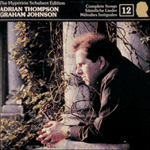Salieri's course of training included all manner of exercises in counterpoint, choral writing and the invention of melodies supported by strong bass lines. Some of these are credible compositions in their own right, but it was not long before Schubert's technical studies bore fruit in the songs themselves: the Matthisson settings of 1814 are a marriage—something borrowed, something new—of schooled skill and streams of new invention. Even Schubert needed someone to help him open the floodgates, and Salieri encouraged and released the flow of sensuous melody which might have been staunched by a German-speaking teacher of the old school. The hallmark of the Matthisson songs is graceful melodic invention, but they also show an ability and touching desire to serve the lyric, rather than merely to press it into service. This respect for poet and poetry is a characteristic of the dutiful North German masters who averred that musical invention should not obscure the poetry. But how best really to serve a lyric? Zumsteeg would have had no doubt that his prime responsibility was to conserve the metre of the text when set to music; Schubert is aware of metre most of the time, but ocasionally he overrules its demands when he feels that it is more important that music should reflect the mood and situation of a poem. Trost.
An Elisa is a case in point: Matthisson's classical metre is made into prose to enable the composer to write a recitative which only momentarily breaks into real melody. Schubert might have reasoned that the words are an impassioned attempt to console Elisa, and in real life (which interests him more and more in the full bloom of late adolescence) one does not sing to someone in the depths of bereavement. The composer imagines the poet speaking to Elisa, using the full weight of his persuasive rhetoric and religious conviction to reason with her. Recitative seems the musical form most appropriate to the task—it mirrors spontaneous emotion, reflecting the shape and meaning of the words as the poem unfolds. Modulation also seems to occur in an almost unpremeditated way, and compound time is used only when melody intrudes at odd moments, as at the end of verse 2; the same lilt pervades
Lied der Liebe—the beloved's spirit floats into the conversation in both cases. The final cadence, turning around a corner into the radiant consolation of C major, seems to gaze into the infinity of the afterlife. The recitative style of this song is a long way from that of Mozart and Italy—Gluck was no doubt one of the models (see also
Die Sommernacht), but Schubert's hybrid owes much to Zumsteeg too. A number of the songs of this period, including some of the Ossian settings, look forward to Wagner in the creative and flexible way word and tone are made to combine in heightened speech.
Trost.An Elisa seems nearer to Bayreuth than is comfortable for those who hold to the notion that Wagner was utterly innovative in everything he did. Like Schubert himself, that master magpie developed his style from the legacy of what had gone before.
from notes by Graham Johnson © 1991


 Schubert: The Complete Songs
Schubert: The Complete Songs Schubert: The Hyperion Schubert Edition, Vol. 12 - Adrian Thompson
Schubert: The Hyperion Schubert Edition, Vol. 12 - Adrian Thompson
